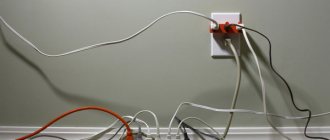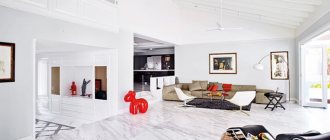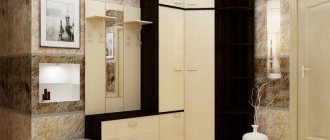The appearance of the ceiling plays a big role in the design of the room. Design can not only correct design flaws, but also become the main accent of the interior or a neutral background for decoration. Let's look at how a high-tech style ceiling is created. We will talk about the most popular materials, as well as the choice of lighting devices.
What distinguishes the high-tech style from other trends
This design trend appeared in the 70s of the twentieth century and was initially used for industrial premises. The main design features are related to this. High-tech is characterized by:
- strict straight lines;
- cold tones;
- free space;
- minimalism in decoration;
- bright lighting;
- contrasting color combinations;
- technological effectiveness, use of modern household appliances.
Lush decorations and natural materials are excluded. Metal, glass (including acrylic), mirrors, plastic, and polyester fabric are used. Sometimes concrete or brick surfaces are left covered only with a protective varnish. Areas of rough texture emphasize the manufacturability of other materials.
Blinds, sliding doors and open communications fit perfectly into the style. The appearance of the room may resemble a spaceship, a scientific laboratory or other place associated with high technology.
Electronic watches, black and white photographs, abstract paintings, vases and other decor of simple shapes are used as accents. But with accessories it is necessary to observe moderation. Collections of trinkets and souvenirs will not fit into this direction.
What materials are used for high-tech ceilings?
There are different design options. The choice depends on your budget and personal preferences. Some materials are combined with each other.
Painting
This method of finishing the ceiling is the simplest, but it does not look as impressive as others. Therefore, it is more suitable for walls or ceilings with interesting decor. Then the overlap will serve as a neutral background that does not destroy the overall concept.
For high-tech, glossy paints that reflect light are preferred. This coating visually raises the ceiling. But it is important to level the slabs - defects are more noticeable on a smooth surface.
The following colors are mainly used:
- white;
- light gray;
- black;
- red;
- blue;
- yellow;
- green.
Choose pure tones, without shades or transitions. Combinations of two or three colors look good, for example, in the form of stripes or geometric shapes on a contrasting background. Such decor can correct design flaws or draw attention to a certain area.
Stretch ceiling
Vinyl film and polyester fabric are materials that perfectly match the spirit of this style. They use different colors and textures.
White is one of the main tones. Matte film or fabric is chosen for bedrooms, where a riot of colors interferes with a relaxing rest. In this case, it is better to make a bright floor - for example, self-leveling.
More popular are textures that give a play of light. On satin the reflection is softer. Glossy makes the room taller, but the refraction of rays from a chandelier directed upward will hit the eyes, so the model is chosen more carefully, taking into account the reflective ability of the material.
Another popular color is light gray, similar in shade to chrome or aluminum. Looks best on metallic texture film.
Black is often used, mainly in combination with white or silver. The ceiling is only made of dark material and puts too much pressure on your head. Although this effect is partly compensated by the varnish texture. In spacious, high rooms, such decoration is acceptable.
For stretch ceilings in the high-tech style, bright colors are also used, which should be pure, without mixing with others. Tones are combined in multi-level structures or welded canvases. Depending on the location, different options are possible. For example, functional areas are highlighted with colors. In other cases, they create a striped or checkerboard ceiling. Often they combine not only colors, but also textures. A classic combination of this kind is black gloss and white matte.
If the room is high enough, luminous ceilings are created. To do this, stretch a translucent film, and behind it LED strips and panels are placed. With this technology, the level drops by about 30 cm. The entire ceiling, as well as individual fragments, can glow. Such radiance is diffused and comfortable for the eyes.
Drywall
This material allows you to create complex multi-level ceilings. With the help of gypsum plasterboards, structures with straight or rounded shapes, false beams, lowering the level around the perimeter or in the center, over a certain area, etc. are obtained. The complex angular shapes of plasterboard ceilings fit well into the high-tech style.
The surface is leveled and painted, choosing the same colors as in the previous options. You can add mirrored plexiglass panels or film with a reflective effect.
Often, only the lower level is made from plasterboard sheets, and PVC film is stretched as the upper level. Then a game of textures is added.
Non-standard solutions
Other modern materials are also suitable. For example, an Armstrong suspended ceiling. The frame is assembled from guides located along and across the ceiling. Cassettes made from different materials are inserted into the resulting square cells. For a high-tech style, choose plastic, metal or mirror, often in combination.
All ceiling panels are of standard size, so it is convenient to combine them. Some of the cassettes are replaced with lighting devices, which are also produced to fit the dimensions of the cells.
Slatted ceilings are also popular. They are durable and easy to install. The materials chosen are matte and chrome-plated metal or plastic.
Advice! It is better to place the slats across the room - the room will seem wider.
A fairly simple option to implement is to leave concrete slabs. But the surface is varnished, because the material easily absorbs moisture and collects dust.
Suitable color and design options
The most successful design solution for decorating a high-tech ceiling would be a suspended structure or tension fabric. Both options allow you to create multi-level compositions, as well as “play” with different volumes.
A good solution for creating a high-tech interior would be to use the Armstrong suspended ceiling system. It is difficult to find a more suitable urban design option. The combination of metal frame parts with slabs of regular geometric shape will perfectly emphasize the main idea.
Another good idea for decoration would be stretched fabrics. The films can be chosen in any color, which will allow you to complement the rest of the room’s design with a plane of metallic or gray shade. Several levels, combined with neon or LED lighting, will allow them to fit perfectly into the rest of the room design.
As for the color scheme, it can be quite diverse. Many people have the opinion that this style is characterized only by dim and rather dark shades. This is not entirely correct. You can use any colors completely freely, and light colors are one of the most popular in this design. What is important is their harmonious combination with other furnishings and maintaining the overall design concept.
However, more often than others, high-tech interiors are decorated in the following colors or shades:
- Grey
- Black
- Blue
- White
- Silver
All of them fit perfectly into this urban style. They are also suitable for decorating the ceiling surface.
High-tech ceiling in different rooms
Each room has its own characteristics that need to be taken into account when decorating. The same direction will manifest itself slightly differently.
Kitchen
This room is perfectly suited to the minimalism and functionality inherent in the high-tech style. Two-level structures that separate the working and dining areas look good. Lighting in the form of an LED strip or spot spots is built into the upper tier. This emphasizes the border and is convenient when cooking.
For small kitchens, it is better to choose light colors and textures with reflective properties. For example, white gloss and gray metallic. And in spacious rooms one of the colors can be bright.
Hallway
Light and cool shades expand the space, which is important for narrow corridors and cramped entrance areas. The abundance of light and reflective textures also works for this.
There is no need to come up with complex designs that take away volume. But a slight lowering of the level in part of the room or imitation of plasterboard beams looks interesting.
Living room
These rooms are usually larger in size than others. Contrasting combinations of black and white would be appropriate in the room. Multi-level structures designate functional areas.
It is advisable to provide several lighting options. The common one unites the space, the additional one makes it possible to read or work, the accent one emphasizes individual objects and the interior.
Advice! Twisted backlight patterns are inappropriate in this style. Straight, strict lines look much better.
Children's
For kids, “high-tech” is too cold and uncomfortable, but an older child or teenager will like it. Here you can show your imagination - for example, decorate a room in the style of a spaceship control room. A round (or other shaped) part of the ceiling is decorated in the form of a starry sky, and the rest is left white or silver.
Other options are also possible. The main thing is to base it on the child’s tastes and interests, then he will feel comfortable.
Bedroom
Here it is worth making the ceiling less contrasting, more calm. White and gray tones promote relaxation and night rest. For low rooms it is better to choose gloss or satin. And if the dimensions allow, you can make a matte surface.
Cabinet
“High-tech” will help create a work environment where nothing distracts from the task. Be sure to add an additional lighting source next to the computer desk.
Bright colors are appropriate in the office. If a colored ceiling seems too bold, add white. Both division into zones and a graphic design (stripes, checkerboard, etc.) are suitable.
Bathroom and toilet
The light glossy texture expands the space. For these rooms, smooth vinyl film or chrome slats are often chosen. But this solution is not suitable for the smallest toilets. The room will resemble a well with tight walls.
Modern - aesthetics and aristocracy
The Art Nouveau style is characterized by classical and aristocratic features; many furniture elements are handmade.
The design of the room in the Art Nouveau style gives the room a spirit of aristocracy and classics. Previously, in terms of furnishings, this trend relied on decorativeness, often at the expense of functionality. But modern designers manage to skillfully combine aesthetics with practicality.
Related article: Window shutters: advantages and disadvantages
Modern is a far from democratic style. This direction involves the active use of handmade products and the use of expensive materials in finishing: noble varieties of wood, natural marble, stone, leather, glass and ceramics.
When decorating a room in a modern Art Nouveau style, special attention should be paid to stained glass windows with plant and floral themes.
Art Nouveau is characterized by the presence of curves and smooth lines that create the illusion of an oncoming wave. The furniture is selected accordingly: with a large number of smooth transitions and a minimum number of corners.
The material for furniture is textiles or genuine leather in sand, chocolate and other natural shades.
In rooms decorated in the Art Nouveau style, you can often find round tables with carved legs, cabinets with curved doors, forged furniture and interior items.
Chandeliers, lamps, floor lamps are a must-have addition to the style
To highlight the high-tech features and ceiling decoration, it is important to choose the right fixtures. Flowers, gilding, etc. will not work. Lamps should be compact and concise and have a modern look.
Built-in ones are often used. Located in sufficient quantities, they serve as the main source, and one at a time or in small groups as an additional source. Spots are especially popular - models with a movable body that allows you to adjust the direction of the light. Such devices, located on one track, look very technologically advanced.
Chandeliers are also used, but you need to carefully select the model. Compact ones with a strict finish and geometric shapes are suitable. There are lamps without shades, with bare bulbs pointing in different directions.
Attention! If the ceilings are suspended, the distance to the chandelier horns should be at least 20-25 cm. It is taken into account that part of the fastening will be hidden under the canvas.
LED strip is widely used. It is laid between tiers or along the perimeter of the ceiling. It is better to choose the RGB option, which changes color, and connect it to the remote control. Then it will be easy to change the decor in the room, and the interior will become even more technologically advanced.
In the high-tech style, light lines are often used when installing suspended ceilings. A special baguette is attached to the floor slab, into the groove of which an LED strip is inserted. The top of the profile is covered with a translucent insert, and the tension fabric is fixed on the sides. Such lines are bright enough to serve as main lighting.
High-tech ceiling design brings a modern spirit to any room. To create an original design, different materials are used. Don't forget about proper lighting.
Japanese minimalism
The origins of the passion for laconic interiors without unnecessary decor and embellishment should be sought in the east in the classic design of Japan. Frequent earthquakes and peculiarities of philosophy gave rise to a special kind of light and mobile dwellings made actually from paper and bamboo. Sliding partitions and screens are easy to restore and move to a new location, and such weightless structures do not pose a danger during earthquakes. The garden has always been a part of the Japanese interior, so love for nature is also an important factor in the formation of Japanese style. Through the wide sliding openings, not only the landscape penetrated into the rooms, but also sunlight, which was the main source of illumination in the house. The result of this layout is a special attitude towards lamps, which should provide soft, diffused light, creating atmospheric twilight, rather than bright accents.
Japan gave minimalism a love for maximally open spaces, because in such a densely populated country, every centimeter of free space is especially highly valued. Of course, not all the features of traditional Japanese minimalism are applicable in our reality, but some of the techniques are quite possible to use.
Low Japanese furniture of simple shape and characteristic light partitions in the bedroom interior, Cinius bed
Techniques of Japanese minimalism for real life:
- try to free up as much free space as possible, and if you need to zone the room or make some part of it more private, use light paper, bamboo or silk screens
- give preference to several natural shades: white, black, gray, beige, brown
- choose low furniture of strict geometric shapes without decoration
- There should be no unnecessary items in the interior, so all things are hidden in cabinets with sliding doors, built-in furniture and various niches are relevant
- use simple finishing materials: wood, brick, concrete, bamboo mats, etc. However, since there is no decor in such an interior, special requirements are imposed on the quality of all materials.











